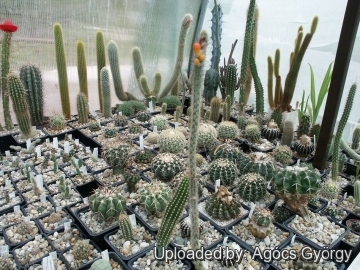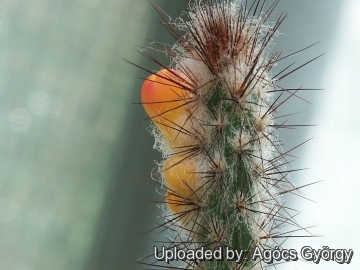Accepted Scientific Name: Arrojadoa dinae subs. eriocaulis (Buining & Bredero) N.P.Taylor & Zappi
Cactaceae Consensus Init. 3: 7. 1997

Arrojadoa multiflora Photo by: Agócs György
Flowers. Rebutialand cactus collection Demjén, Hungary.
Origin and Habitat: Arrojadoa multifloraSN|4857]]SN|4857]] is found in southern Bahia (Brazil) from the south of Caetite to northwest of Riacho de Santana and east of Tanque Novo. It is only known from four fragmented sites (extent of occurrence less than 5,000 km2). The subpopulations have a small number of plants (less than 250 per subpopulation) and are declining due to habitat loss. The total number of mature individuals is less than 5,000.
Altitude range: It grows at altitudes between 550 and 1,400 metres above sea level.
Habitat and Ecology: This cactus is found in campo rupestre and cerrado. It also grows among crystalline rocks and in sand. The generation length of this succulent shrub is ten years or less. The main threats are deforestation for agro-industry farming and urbanization. The decline has probably exceeded 30 percent in the last 30 years and is suspected to continue at the same or an even higher rate.
Synonyms:
See all synonyms of Arrojadoa dinae
back
Accepted name in llifle Database:Arrojadoa dinae Buining & BrederoKakteen Sukk. 24(5): 99. 1973Synonymy: 2
Accepted name in llifle Database:Arrojadoa dinae subs. eriocaulis (Buining & Bredero) N.P.Taylor & ZappiCactaceae Consensus Init. 3: 7. 1997Synonymy: 10
back
Common Names include:
RUSSIAN (Русский): Аррожадоя многоцветковая
Description: Arrojadoa multifloraSN|4857]]SN|4857]] is a columnar cactus with slender stems, up to 80 cm tall. The stems, usually single, are covered with yellowish brown spines and greyish-white wool. Towards the apex appears a pseudocephalium (area where the flower buds and fruit are produced) composed of long, thin red bristles. The bicolored tubular flowers are pinkish-red or carmine-red with many petals. Flowers bloom at night. Hunt et al. (2006) indicated that this taxon was best assigned to either Arrojadoa dinaeSN|4830]]SN|4856]] or Arrojadoa eriocaulisSN|4856]]SN|4830]], but thought the latter to be the most likely. Other authors consider Arrojadoa multifloraSN|4857]]SN|4857]] a good species.
Derivation of specific name: The species name multiflorus = multiflorum describes the numerous flowers that appear on plants.
Stem: About 80 cm long, erect, 10-20 mm thick, glossy dark green.
Root: Tuberous.
Ribs: 7-8, 2-3 mm high, dull.
Areoles: 4-7 mm apart, 1-2 mm wide, circular, white, with downwardly facing white hairs, 5-10 mm long.
Radial spines: 12-15 needle-like, brown or rusty-red to white pointing sideways 5-10 mm long.
Central spines: 1 to 3.
Cephalia: Towards the apex, lateral on a somewhat thickened part of the stem, with enlarged areoles, densely filled with white wool and many soft rust-red bristles 15-30 mm long.
Flowers: About 3 cm long; tube 11 mm long, 4 mm wide, pale inside, outside somewhat ruby, with very little scales; filaments of the same colour of petals 4-8 mm long; anthers small golden yellow; pistil of the same colour of petals 22 mm long, stigma lobes 5,2-3 mm long; petals straight, pointed, outer ones about 7 mm long, 3-4 mm wide, pale yellow with a crimson mid-stripe; inner ones 5 mm long, 2.5 mm wide, very pale yellow. The species is self-fertile.
Blooming season: Flowers appear in flushes during the growing season.
Fruits: 12-15 mm long, 8 mm wide, brownish-red, club-shaped. The fruits remain long on the plant.
Seeds: 1.5 mm long, 1.2 mm wide, 1 mm thick, blackish.
Subspecies, varieties, forms and cultivars of plants belonging to the Arrojadoa dinae group
Arrojadoa dinae, Arrojadoa multiflora, Arrojadoa eriocaulis and Arrojadoa beateae are a group of distinct but related species in Minas Gerais and Bahia. They are readily distinguished by their subterranean tubers, stems, wood anatomy, bi-colored flowers, and fruits. Most authors regard them as conspecific under the oldest name Arrojadoa dinae. However some studies in the field, show that it should be better to maintain these taxa as separate species. In some cases they even grow together (A. dinae, A. eriocaulis) without hybridization.
- Arrojadoa beateae P.J.Braun & Esteves
 Arrojadoa dinae Buining & Bredero: (subsp. dinae) has stems up to 30 cm tall, usually with 11 ribs, whitish spines, and brownish carmine flowers with yellow interiors. Distribution: Bahia.
Arrojadoa dinae Buining & Bredero: (subsp. dinae) has stems up to 30 cm tall, usually with 11 ribs, whitish spines, and brownish carmine flowers with yellow interiors. Distribution: Bahia.- Arrojadoa dinae subs. eriocaulis (Buining & Bredero) N.P.Taylor & Zappi: typically has 8-9 ribs, yellowish brown spines, and light violet-pink flowers. Distribution: Minas Gerais.
 Arrojadoa dinae var. nana P.J.Braun & Esteves: this is a smallish form strictly related to Arrojadoa dinae subs. eriocaulis.
Arrojadoa dinae var. nana P.J.Braun & Esteves: this is a smallish form strictly related to Arrojadoa dinae subs. eriocaulis. Arrojadoa eriocaulis var. rosenbergeriana Van Heek & W.Strecker: Distribution: East of Mato Verde, Minas Gerais, Brazil.
Arrojadoa eriocaulis var. rosenbergeriana Van Heek & W.Strecker: Distribution: East of Mato Verde, Minas Gerais, Brazil. Arrojadoa multiflora F.Ritter: has stems, up to 80 cm tall. Ribs 7-8. Flowers inside pale yellowish , outside somewhat ruby. Distribution: Bahia.
Arrojadoa multiflora F.Ritter: has stems, up to 80 cm tall. Ribs 7-8. Flowers inside pale yellowish , outside somewhat ruby. Distribution: Bahia.
Bibliography: Major references and further lectures
1) Braun P., “A.dinae Buining et Brederoo var. nana Braun et Esteves - Eine neue Arrojadoa-Sippe aus Minas Gerais (Brasilien)”, Kakt. und and. Sukk., 42: 190-195, 1991
2) Říha J., “Arrojadoa multiflora Ritter”, Kaktusy, 19: 95-96, 1983
3) Ritter, “Kakteen in Südamerika” 1: 89-90, 1979
4) Machado, M. 2013. Arrojadoa multiflora. The IUCN Red List of Threatened Species. Version 2015.1. <www.iucnredlist.org>. Downloaded on 09 June 2015.
5) Edward Anderson “The Cactus family” Timber Press, Incorporated, 2001
6) Nigel P. Taylor, Daniela C. Zappi “Cacti of Eastern Brazil” Royal Botanic Gardens, Kew, 2004
7) Urs Eggli, Leonard E. Newton "Etymological Dictionary of Succulent Plant Names". Birkhäuser 2004
8) Stuart Max Walters “European Garden Flora: A Manual for the Identification of Plants Cultivated in Europe, Both Out-of-Doors and Under Glass” Cambridge University Press, 27 lug 1989
 Flowering habit. Rebutialand cactus collection Demjén, Hungary. Photo by: Agócs György
Flowering habit. Rebutialand cactus collection Demjén, Hungary. Photo by: Agócs György Buds. Rebutialand cactus collection Demjén, Hungary. Photo by: Agócs György
Buds. Rebutialand cactus collection Demjén, Hungary. Photo by: Agócs GyörgyCultivation and Propagation: Arrojadoa multifloraSN|4857]]SN|4857]] is not particularly difficult on own roots providing it is given a little extra heat during the winter, but this and all its relatives do best when grafted.
Growth rate: It is a relatively rapidly growing and easily flowering species that will make clumps given the best conditions.
Soils: It likes very porous standard cactus mix soil.
Repotting: Use pot with good drainage.
Watering: It should be watered generously during the growing season, keep dry in winter. Water them less than average if in bigger pots, small pots preferred.
Fertilization: Feed with a high potassium fertilizer in summer.
Hardiness: Reputedly sensitive to frost, but less so if kept on the dry side prior to, and during, cold weather. However warmth throughout the year will increase the grower's success (8-12°C during rest season).
Exposition: Outside bright, hot conditions or afternoon shade, inside it needs bright light, and some direct sun. Strong light encourages flowering and heavy wool and spine production.
Uses: It is an excellent plant for container growing. It always looks good and stays small.
Pests & diseases: It may be attractive to a variety of insects, but plants in good condition should be nearly pest-free, particularly if they are grown in a mineral potting-mix, with good exposure and ventilation. Nonetheless, there are several pests to watch for:
- Red spiders: Red spiders may be effectively rubbed up by watering the plants from above.
- Mealy bugs: Mealy bugs occasionally develop aerial into the new growth among the wool with disfiguring results, but the worst types develop underground on the roots and are invisible except by their effects.
- Scales: Scales are rarely a problem.
- Rot: Rot is only a minor problem with cacti if the plants are watered and “aired” correctly. If they are not, fungicides won't help all that much.
Propagation: Division, direct sow after last frost or (often) graft. Seeds germinate in 7-14 days at 21-27° C in spring, remove the glass cover gradually as the plants develops and keep ventilated, no full sun for young plants! To make a cutting twist off a branch and permit it to dry out a couple of weeks, lay it on the soil and insert the stem end partially into the soil. Try to keep the cutting upright so that the roots are able to grow downward.












